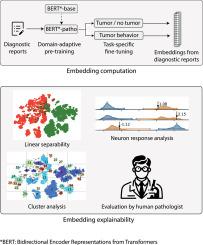微调语言模型嵌入以揭示领域知识:从可解释的人工智能角度看医疗决策
IF 7.5
2区 计算机科学
Q1 AUTOMATION & CONTROL SYSTEMS
Engineering Applications of Artificial Intelligence
Pub Date : 2024-11-15
DOI:10.1016/j.engappai.2024.109561
引用次数: 0
摘要
整合大型语言模型(LLMs),从电子健康记录中检索目标医学知识,可使医学研究取得重大进展。然而,认识到在医疗保健领域使用 LLMs 所面临的挑战对于成功实施 LLMs 至关重要。挑战之一是医疗记录结合了非结构化文本信息和高度敏感的个人数据。这反过来又凸显了对可解释人工智能(XAI)方法的需求,以更好地理解 LLM 在医疗领域的功能。在本研究中,我们提出了一种新型 XAI 工具,以加速数据驱动的癌症研究。我们将来自变换器的双向编码器表征(BERT)模型应用于德语病理学报告,以检验特定领域语言适应和微调的效果。我们在真实病理数据集上演示了我们的模型,分析了诊断报告的上下文表征。通过说明微调模型做出的决策,我们提供了可应用于医学研究的决策值。为了解决可解释性问题,我们对微调模型生成的分类进行了性能评估,由病理专家进行评估。在医学等领域,结合专家评估对医学知识图谱进行检查,可以发现关于关键疾病特征的上下文表示如何分类的宝贵信息。这最终有利于数据的结构化和标签化,并为更先进的 XAI 方法铺平了道路,将文本与其他输入模式(如图像)相结合,从而适用于各种工程问题。本文章由计算机程序翻译,如有差异,请以英文原文为准。

Fine-tuning language model embeddings to reveal domain knowledge: An explainable artificial intelligence perspective on medical decision making
Integrating large language models (LLMs) to retrieve targeted medical knowledge from electronic health records enables significant advancements in medical research. However, recognizing the challenges associated with using LLMs in healthcare is essential for successful implementation. One challenge is that medical records combine unstructured textual information with highly sensitive personal data. This, in turn, highlights the need for explainable Artificial Intelligence (XAI) methods to understand better how LLMs function in the medical domain. In this study, we propose a novel XAI tool to accelerate data-driven cancer research. We apply the Bidirectional Encoder Representations from Transformers (BERT) model to German language pathology reports examining the effects of domain-specific language adaptation and fine-tuning. We demonstrate our model on a real-world pathology dataset, analyzing the contextual representations of diagnostic reports. By illustrating decisions made by fine-tuned models, we provide decision values that can be applied in medical research. To address interpretability, we conduct a performance evaluation of the classifications generated by our fine-tuned model, as assessed by an expert pathologist. In domains such as medicine, inspection of the medical knowledge map in conjunction with expert evaluation reveals valuable information about how contextual representations of key disease features are categorized. This ultimately benefits data structuring and labeling and paves the way for even more advanced approaches to XAI, combining text with other input modalities, such as images which are then applicable to various engineering problems.
求助全文
通过发布文献求助,成功后即可免费获取论文全文。
去求助
来源期刊

Engineering Applications of Artificial Intelligence
工程技术-工程:电子与电气
CiteScore
9.60
自引率
10.00%
发文量
505
审稿时长
68 days
期刊介绍:
Artificial Intelligence (AI) is pivotal in driving the fourth industrial revolution, witnessing remarkable advancements across various machine learning methodologies. AI techniques have become indispensable tools for practicing engineers, enabling them to tackle previously insurmountable challenges. Engineering Applications of Artificial Intelligence serves as a global platform for the swift dissemination of research elucidating the practical application of AI methods across all engineering disciplines. Submitted papers are expected to present novel aspects of AI utilized in real-world engineering applications, validated using publicly available datasets to ensure the replicability of research outcomes. Join us in exploring the transformative potential of AI in engineering.
 求助内容:
求助内容: 应助结果提醒方式:
应助结果提醒方式:


